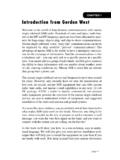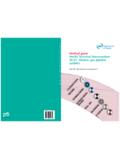Transcription of Guidelines for Multi-Line Telephone Systems
1 July 2016 State 911 Committee Box 30634 Lansing, Michigan 48909 Guidelines for Multi-Line Telephone Systems Multi-Line Telephone system Guidelines July 2016 1 | Page introduction and Purpose of this Guide This guide is for Multi-Line Telephone system (MLTS) owner/operators, local service providers, 911 network providers, and 911 agencies to use to better understand Michigan Public Service Commission (MPSC) Rules (referred to in this guide as the Rules), regarding the provision of 911 service over Multi-Line Telephone Systems . While this document provides guidance with respect to compliance with the MLTS Rules, the location and service diversity of sites utilizing Multi-Line Telephone Systems require that MLTS operators communicate with their local 911 service provider and telecommunications equipment provider to facilitate compliance with the rules.
2 While this guide contains useful information, it should not be used as the definitive resource for MLTS implementation and the actual rules, which can be found on the State s Office of Regulatory Reinvention website at: MLTS operators may also find it beneficial to communicate with the administrator of their jurisdiction s 911 center, also known as a Public Safety Answering Point (PSAP). A list of all the PSAPs in Michigan can be found on the State 911 Committee s website at: What is E911 and Why is it Important? Residents of Michigan have depended on reaching local emergency services by dialing 911 for decades. Today, the advancement of technology allows for E911 or Enhanced 911, which means that when 911 is dialed, the calling party s callback number and location information are delivered to the geographically appropriate Public Safety Answering Point.
3 The delivery of caller-location information to the PSAP call-taker s screen is the feature that sets E911 apart from basic 911. E911 technology significantly improved PSAPs ability to effectively deliver critical public safety and emergency response services in a timely manner. In many instances, it has proven to be a life-saving, essential emergency response tool in providing critical information when the caller is unable to verbally communicate his or her location, including when the voice call is dropped, discontinued, and cannot be reestablished. In order to provide the specific location information for a caller, every Telephone capable of dialing 911 must have an Automatic Location Information (ALI) record in the 911 database to identify the caller s specific location.
4 Under Michigan law, the provision of an Emergency Response Location (ERL) for every Telephone capable of dialing 911 on a Multi-Line Telephone system is required by December 31, 2019. If ALI records are properly entered and maintained in the 911 database, a caller s location or ERL will display on the PSAP display, reducing response time for emergency services. Multi-Line Telephone system Guidelines July 2016 2 | Page Additional note in regard to the MLTS rules: While not required in the rules governing MLTS within the State of Michigan, the State 911 Committee (SNC) recognizes the direct outward dialing of 911 as a voluntary best practice. This means that MLTS Systems may be programmed to allow the caller to dial the numbers 911 without having to dial 9 or another digit first.
5 Why is location information so important? There are many reasons a person calling 911 might not be able to communicate his or her specific location to the 911 dispatcher. Here are a few examples: Someone is choking, having a heart attack, or some other physical injury which prevents them from speaking. The caller is unable to talk or are fearful of speaking, for instance during a bank robbery at a branch location of a banking network. A person is disabled in some way that makes Telephone communication difficult or impossible, such as being deaf or mute. The caller is a child or visitor, and doesn t know their address/location. The caller cannot speak English. These are all real and common situations. By automatically providing specific location information through the 911 system , the 911 dispatcher is able to immediately relay fire, police, or EMS responders to the caller s location, even when that person is unable to communicate that information.
6 How E911 Works To better understand the purpose of new rules governing MLTS operators, here is an outline of how 911 calling works in general. Let s begin with an example: Fred Smith calls 911 from his wired residential phone. The 911 dispatcher receiving the call sees the location of the caller s phone on a special computerized 911 phone screen (the 911 community calls that location information ALI for Automatic Location Identification). The 911 dispatcher sees something like this: (517) 868-1212 12:23 09/17/13 Calling phone number (called ANI) and the time/date FRED SMITH Customer s name, as appears on the billing record 168 MAPLE AV Fred s street address APT 302 Fred s location information, often an apartment number YOURCITY, MI City and state of Fred s phone s location Note that Fred did not enter any of this information about his phone.
7 When his phone was installed by his phone company, his subscriber s name (FRED SMITH), his street address, city and state ( 168 MAPLE AV and YOURCITY, MI ), and other helpful location information ( APT 302 ) were provided by Fred s phone company to a centralized 911 database (the ALI Database ) that is maintained as part of the centralized 911 system in Michigan. Multi-Line Telephone system Guidelines July 2016 3 | Page Of special note is that the phone company is responsible for entering and submitting Fred s street address and city name. When they submit this information, the information provided must be an address and city that can be found on the Master Street Addressing Guide (MSAG), a list of street names and permissible numbers entered into the 911 system database.
8 Because of this, when Fred dials 911 from his residential phone, the 911 Telephone switching equipment can look up Fred s location information from the ALI Database using Fred s calling phone number as the lookup key. Here is how the process works with an MLTS system that does not provide emergency location information: Melissa Smith, Fred s wife, works at Acme Motors, a large company with a MLTS or PBX phone system that provides phone service for several buildings that are in a clustered building complex. Melissa calls 911 from the extension in her cubicle, which is located on the third story of a secondary building known as Building B at 100 Main Rd, Michigan. Without MLTS compliant information, the location information presented to 911 dispatchers can be much less useful, not useful at all, and sometimes downright misleading.
9 Prior to enacting the provisions of MPSC Rule 484, the 911 dispatcher often sees something like this: (517) 868-4000 12:23 09/17/13 Main MLTS/PBX phone number (not Melissa s extension) ACME MOTORS Customer s Name as appears on their billing record 100 MAIN RD Street Address of the MLTS/PBX switch location (which is not necessarily Melissa s actual location address) _____ The Location field is empty YOURCITY, MI This is the city of the PBX (not Melissa s workplace) When Melissa makes a 911 call from her work extension, the 911 dispatcher may have no information where Melissa is located, or could be led to believe that she is at 100 MAIN RD. In many of these situations, the 911 dispatcher often receives a location that is in another building, far away from where the caller is actually located.
10 In extreme examples, there could be 2,000 phones in 10 different buildings in 3 cities that are connected to one MLTS/PBX switch, and the ALI is always identified as 100 MAIN RD, rather than the caller s actual address. What is a Multi-Line Telephone system ? A Multi-Line Telephone system or Private Branch Exchange Telephone system (PBX), is a Telephone system comprised of common control units, telephones, and controls providing local Telephone service to multiple end-users. Specifically, an MLTS Telephone system consists of a computerized Telephone switch, typically managed by technical staff or vendors. It is often located in a particular room or closet, and connects to dozens, hundreds, or thousands of extension phones located in offices, rooms, workspaces, classrooms, or other locations.

















